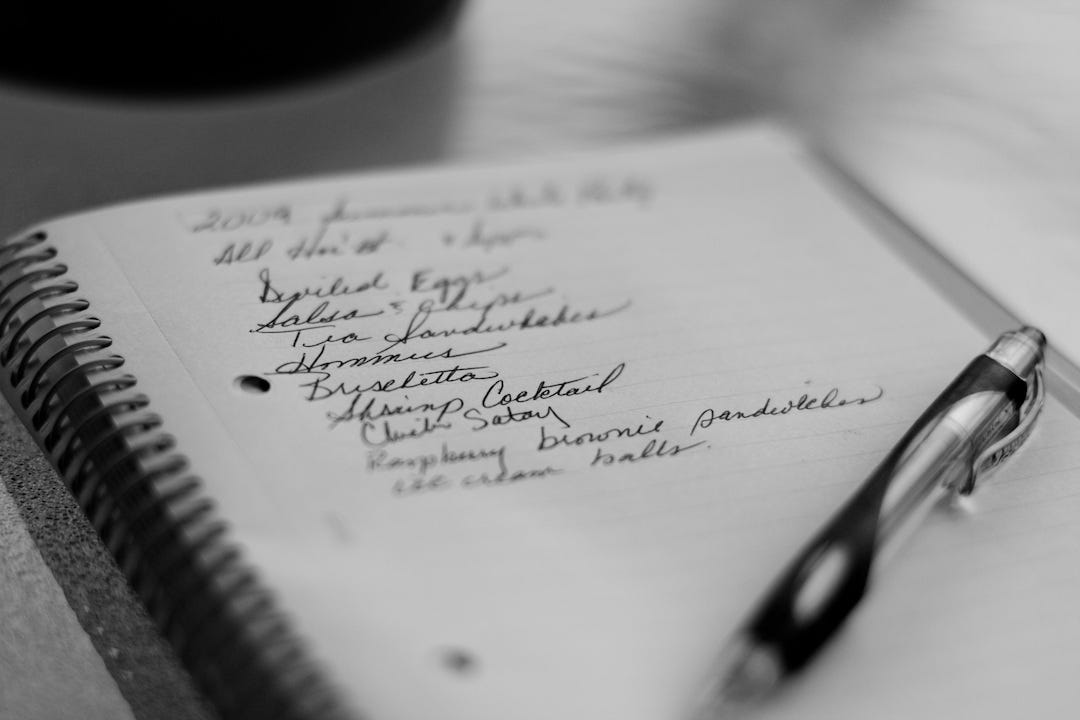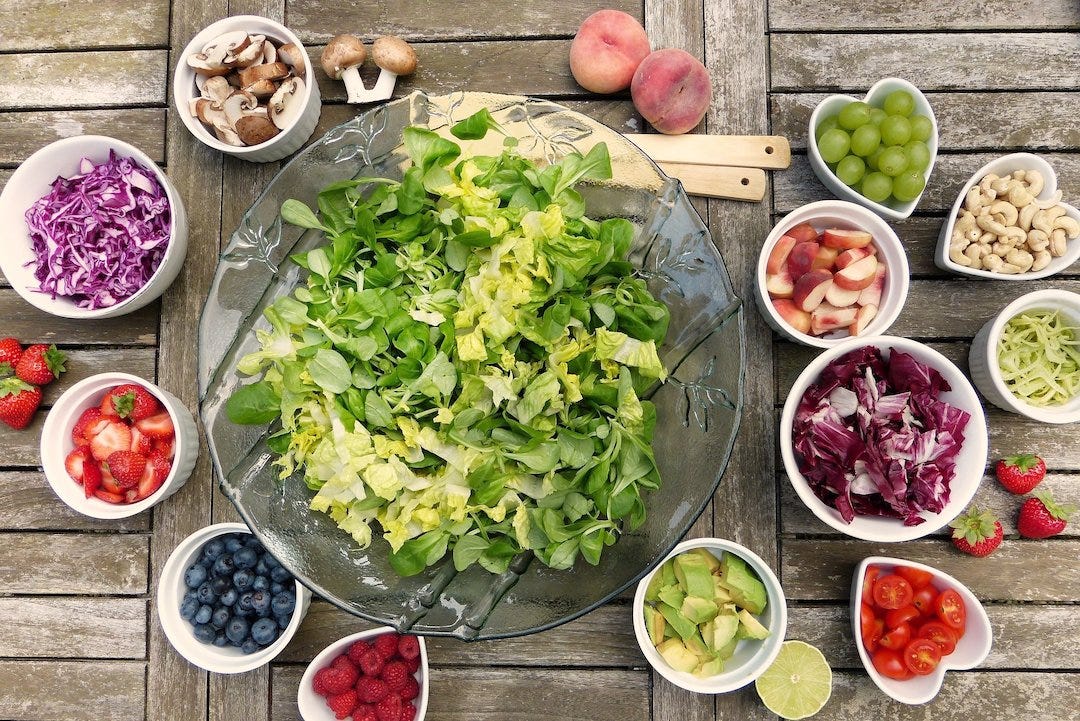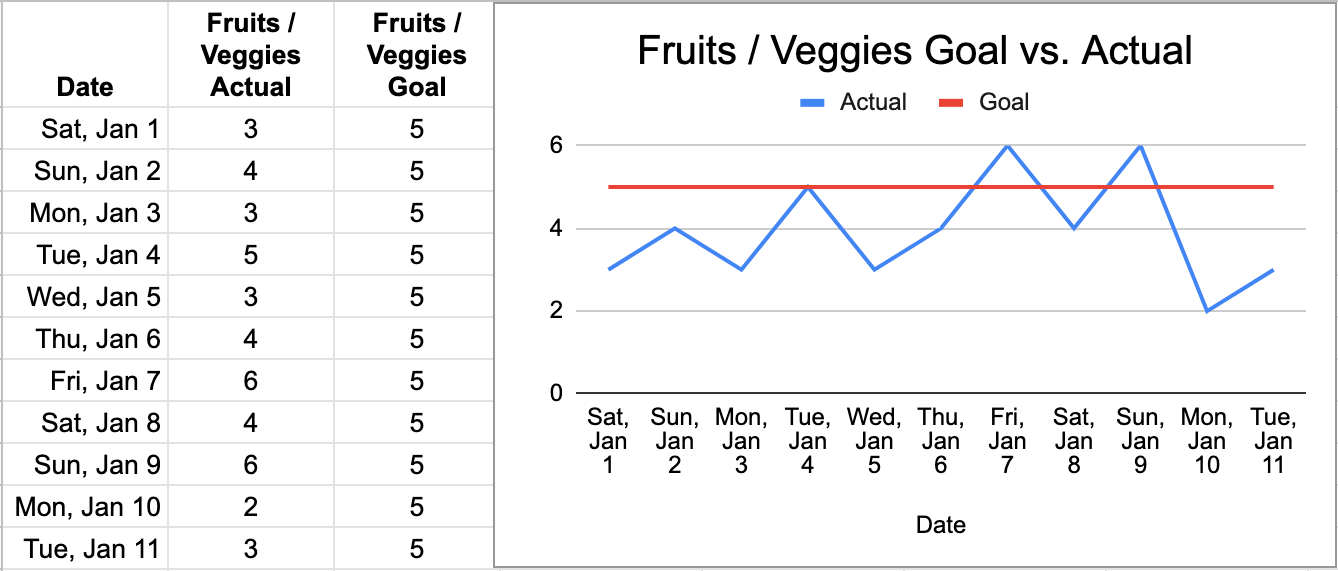How to Actually Eat 5 Fruits & Veggies Every Day
This is part of my blog series Practical Self-Help for Introspective People.
You do not rise to the level of your goals. You fall to the level of your systems.
― James Clear, Atomic Habits
Hey, friends!
It's a new year, and we've made a resolution to eat more fruits and vegetables—we want to be healthy! Unfortunately, most of us fail for a few days and give up. Next year we re-commit, fail, and continue the cycle.
(Sorry for the gloomy outlook! I promise there’s a solution.)
So in this short guide, I’ll walk you through five tools that I personally use to consistently eat lots of fruits and vegetables. This advice goes beyond your typical “eat tasty veggies” and “drown ‘em in ranch.” Eating five a day boils down to two things: Maintaining motivation and having good systems. And both of these are relatively easy to set up.
Ok, enough jibber-jabber! Let’s get started.
Tool 1: Manage your motivation
I want to show you a trick to maintain your motivation to eat more fruits and vegetables. But first, we need to talk about the philosopher René Girard (1923–2015). Girard put forward this idea called mimetic desire, which says that not only do we imitate other humans, but we imitate their desires. Spend enough time with someone, and we’ll desire what they desire.
I’ve seen this play out time and time again with my kids. A toy will sit unused on the floor for hours, or days. As soon as one kid picks it up, the other one wants it, and a fight ensues. This also happened when my daughter was three, and she overheard us discussing the shopping list. I was trying to persuade my wife to get a pie, but instead of saying the word pie, I spelled it P-I-E. So my daughter piped up and said, “I want some P-I-E!” She had no idea what we were talking about, but because I wanted it, she wanted it too.
Imitating the desires of other people certainly has a dark side. The entire advertising industry exists to exploit this idea. And yet, we can use this concept for good. We can use it to boost our motivation to eat five fruits and veggies each day.
Here’s how it works: Spend time with media that shows people eating fruits and vegetables. Watch videos of people making vegan recipes. Listen to podcasts & audiobooks that extol the benefits of adding produce to your life. You don’t have to become vegan yourself, but spending time with vegans will train your brain to desire fruits and vegetables.
Honestly, this is the most underused motivational hack I’ve ever seen. I feel like this shouldn't work, like somehow we’re more complex than that. But we're not. Spend time with people you want to be like, and you’ll be like them.
(Does this sound like brainwashing? Yeah, it kind of does. But it's ok because you're training yourself to do good things.)
And yes, I follow my own advice: I have an Audible account with numerous health books. Every morning, as I get ready, I listen to one for 20 minutes. My favorite is How Not to Die. I also follow many pro-vegan YouTube channels like Nutrition Facts and Cheap Lazy Vegan. And if podcasts or documentaries are your jam, there are tons of options.
Again, you don’t have to become vegan yourself. But changing your environment will change your behavior. Spending time with vegans will push your subconscious to want more fruits and vegetables. This is the single easiest way to add produce to your diet.
Summary: If I were your coach, I’d advise you to listen to vegan media every damn day. Furthermore, do it at the same time every day and build a habit, so you don’t even have to think about it.
Tool 2: Bump into fruits and vegetables

Several years ago, my wife bought too much Halloween candy, and we ended up with a ton of leftover Snickers and Reese’s Peanut Butter Cups. So I took the extra candy to work and stuck it in a desk drawer. My wife had instructed me to share the 2 pounds of deliciousness with coworkers. But I didn’t. (Big surprise, there!) Instead, whenever I felt annoyed (or bored), I gobbled a piece of comfort candy. And then a second. Shockingly, my stash of treats didn’t last long.
If I’d stashed the candy in a different office, I would’ve eaten it a lot slower. Let’s be honest, I still would’ve eaten it all, but it would’ve taken me a couple of weeks instead of a couple of days. Proximity matters.
We can use this idea to eat more fruits and vegetables: Put produce where you’ll bump into it. Have a bowl of fruit in the middle of your dinner table. Or put vegetables in the refrigerator door, and stash the condiments in the crisper drawers. Your veggies may not stay as fresh, but you’ll be reminded of them every time you open the refrigerator.
If you keep cans of soda/beer in your fridge, put an apple or an orange on top of each one. Want a cold one? Eat your fruit first! Whatever your favorite snack is, put some fruit in front of it.
In addition, set up daily notifications on your phone to remind you to eat an apple with lunch or some green beans with dinner. (I use my phone’s calendar notifications for building new habits. They’re amazing!)
Bonus points if you remove junk food from your home. When we’re hungry, we typically reach for the tastiest thing. So if a peach is the sweetest thing in our house, we’ll eat more peaches.
Summary: If I were your coach, I’d advise you to always place fruits and vegetables within arm’s reach. Put your favorite vegetables on a shelf where you’ll see them every time you open the refrigerator. And set up notifications to remind you to eat them at snack time and mealtime.
Tool 3: Easy 5-in-1 meals

Confession time: I’m pretty lazy. I don’t want to think about whether I’ve eaten my five fruits and vegetables each day. I don’t want to mentally tabulate how many I’ve had so far. So I found a few easy meals that incorporate five servings.
Let me share two of them.
Meal 1: Green Smoothie
My green smoothie is my easiest meal, and I drink one at least three times a week. Ingredients: Two cups of spinach (or spring mix), kale leaves, a banana, frozen blueberries, nutmeg, cinnamon, ground flaxseed, and water. I blend it for 1 minute and drink it down. Counts as five servings of fruits and vegetables.
For your first smoothie, I recommend skipping the kale because it’s kind of bitter. Also, use spinach instead of spring mix because spinach has almost no flavor. Seriously, you won’t even notice it. In addition, use one cup of spinach, so it’s not too thick. Lastly, use a ripe banana (or two) because they’re sweeter and offset any tartness from the blueberries and any bitterness from the greens.
Don’t give up if the first smoothie turns out terribly. Keep experimenting.
Meal 2: Beans & Veggies Bowl
I combine a tablespoon of olive oil, 1/3 of a can of black or kidney beans, 1.5 cups of frozen mixed vegetables, red pepper flakes, and other spices. (I also add a serving of meat, like cajun andouille sausage if I’m eating meat that day.) Microwave for three minutes, and I have a tasty lunch with three servings of vegetables. I’ll also eat some fruit, a few prunes, and reach my goal of five servings for the day.
Now, I work from home, but I have limited time to prepare lunch. So I typically combine beans, veggies, and red pepper flakes beforehand and store them in plastic containers in my freezer. This way, lunch prep takes little time.
Summary: If I were your coach, I’d advise you to search YouTube/Pinterest/Facebook for easy vegan meals. The point is not to go vegan but to find dead-simple meals that provide your five-a-day in one sitting.
Also, don’t give up if the first recipe turns out terribly. Don’t feel bad for throwing out super gross food. Just keep experimenting.
Tool 4: Create accountability
I’ll be honest, this tool makes me uncomfortable. It means telling others when I fail to reach my goals. It gives me stress. But it works! If I know that I’m reporting my fruits and veggies count, I eat more. Every day.
Accountability comes in two flavors: Daily texts and the Weekly scoreboard review.
Daily texts
This is pretty straightforward: Arrange with a friend or family member to hold you accountable via text message. So every evening, they ask how many fruits and veggies you ate, and you respond with a number. That’s it. That’s all there is.
Example conversation:
Note: I stole this idea from Triggers: Creating Behavior That Lasts by Marshall Goldsmith
Weekly Scoreboard review
Create a Google sheet and record three data points: Today's date, how many fruits/vegetables you ate, and your goal. Also, add a line graph to represent your progress.
Example scorecard:
Next, set up a notification on your phone to remind you to update your scorecard. (My phone chimes at 7:15 am every day.)
Finally, arrange with a trusted friend or family member to be your accountability partner. Schedule a 10-minute weekly meeting with them to discuss how your week went. (I do this on Sundays at 7 am.) Your partner should never criticize or berate you. They should support you. When you reach your goal, they should congratulate you. And when you don’t, they should ask, “What will you do differently this week?”
Now you may not see a drastic change immediately. But over time, knowing that you’re accountable to someone will change your behavior. So keep going even when your behavior doesn’t improve.
Note: I stole this idea from a YouTube video: The scoreboard that is changing my life.
Summary: If I were your coach, I’d advise you to find an accountability partner and regularly report back how you’re doing. Also, set up reminders so you never miss a day.
Tool 5: Make a “master list” of fruits and veggies

Do you ever resolve to eat more salads but forgot to buy greens and tomatoes? Do you ever sit down to make a shopping list but draw a blank on what produce to add? (I used to do this all the freaking time!)
Luckily, I found a solution. I created a “master list” of fruits and vegetables I regularly consume. Here’s what’s on my “master list”:
Dried fruit: Prunes, Raisins
Frozen vegetables: Peas, Mixed veggies, California blend
Canned fruit in extra light syrup: Pears, Peaches, Mandarin oranges
Canned vegetables: Corn, Green beans, Kidney beans, Black beans, Diced Tomatoes, Diced green chilies
Bagged greens: Spinach, Spring mix
Fresh fruits: Apples, Bananas, misc. in-season fruits
Fresh vegetables: Kale, Garlic, Carrots, Mushrooms, Celery, Broccoli, Zucchini, Tomatoes, Jalapeños, Green onions, Red onions, Red/Green bell peppers, Sugar snap peas
Now, I don’t buy every item when I go shopping—that’d be a lot! But I review the list every Saturday, consider what I’ll eat the coming week, and add those to my grocery list. (My phone holds my “master list,” but you can use paper if you like.)
I also go to Costco every 2-3 weeks and keep a short “master list” for it:
Dried apricots
Bag of broccoli
Fresh berries
Frozen blueberries
Sidenote: I buy a lot of canned/frozen/dried items because they last a long time and require no chopping. (My wife recently bought a couple of bags of frozen chopped onions, just to make her life easier.) It's ok to eat healthy without ever chopping anything. No one will judge you. And no one gets a medal for slicing veggies, fruits, and possibly fingers. (Though, if you’re excited to chop stuff, buy a sharp knife and/or a mandoline slicer.)
Summary: If I were your coach, I’d advise you to create your own master list of fruits and vegetables. This will take time, so don’t worry if the list isn’t complete the first time you make it. Just keeping adding stuff. Also, set up a digital reminder to review your “master list” before you shop.
Bonus points if you should take this one step further and have a “master list” for everything you buy at the grocery store, from tuna fish to toilet paper. (Stewie’s list has 75+ items grouped by category.)
Where to start

While I can’t tell you which tool to start with, let me share how this journey started for me. Five years ago, a vegan friend recommended How Not to Die. So I bought the audiobook and was astounded by the mountain of research demonstrating the benefits of eating a plant-based diet. Immediately, more vegetables showed up in my meals.
I’m pretty clueless in the kitchen, but that didn’t stop me from testing various smoothie recipes. One memorable one was just blended salsa that made me nearly barf. (Seriously, no drink should incorporate raw onions!) After lots of failures, I eventually found a concoction I liked. And I graduated from buying 12oz bags of frozen blueberries to buying 5lb ones.
In addition, I experimented with building habits. Many failed to stick, but one that did was the habit of buying a bag of fresh spinach every couple of weeks. I hate to waste food, so it was a race against time to make enough smoothies before the spinach went bad. Every time I bought greens, I was guaranteed to drink 4–5 smoothies.
That’s my story. That’s how I got started. And I've never looked back.
What will your story be?
Thanks to Diane Callahan and Thomas Weigel for reading drafts of this.




